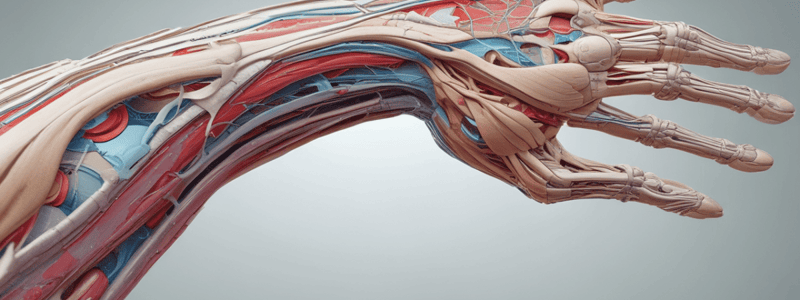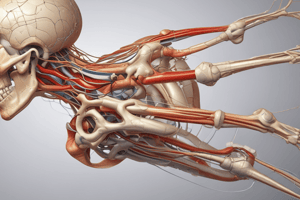Podcast
Questions and Answers
What muscles are innervated by the deep branch of the radial nerve?
What muscles are innervated by the deep branch of the radial nerve?
- Muscles in the medial compartment of the forearm
- Muscles in the posterior compartment of the forearm (correct)
- Muscles in the lateral compartment of the forearm
- Muscles in the anterior compartment of the forearm
Which of the following is the most common cause of radial nerve palsy (wrist drop)?
Which of the following is the most common cause of radial nerve palsy (wrist drop)?
- Compression of the nerve in the axilla
- Fracture of the radial groove of the humerus (correct)
- Injury to the nerve in the forearm
- Carpal tunnel syndrome
Which of the following is a function of the median nerve?
Which of the following is a function of the median nerve?
- Motor innervation to the muscles of the anterior forearm and hand (correct)
- Sensory innervation to the lateral half of the palm
- Sensory innervation to the dorsal hand and fingers
- Motor innervation to the muscles of the posterior forearm
Which of the following is a common site of median nerve injury?
Which of the following is a common site of median nerve injury?
Which nerve is responsible for the cutaneous innervation of the dorsal hand and fingers?
Which nerve is responsible for the cutaneous innervation of the dorsal hand and fingers?
Which nerve is responsible for the motor innervation of the muscles in the anterior compartment of the arm?
Which nerve is responsible for the motor innervation of the muscles in the anterior compartment of the arm?
Which muscle is NOT innervated by the musculocutaneous nerve?
Which muscle is NOT innervated by the musculocutaneous nerve?
Which branch of the brachial plexus is most likely to be injured due to its location?
Which branch of the brachial plexus is most likely to be injured due to its location?
Which nerve is responsible for innervating the muscles that abduct and laterally rotate the arm at the shoulder joint?
Which nerve is responsible for innervating the muscles that abduct and laterally rotate the arm at the shoulder joint?
Which branch of the brachial plexus provides sensation to the lateral aspect of the forearm?
Which branch of the brachial plexus provides sensation to the lateral aspect of the forearm?
Which nerve is responsible for extending the forearm at the elbow joint?
Which nerve is responsible for extending the forearm at the elbow joint?
Which branch of the brachial plexus is most likely to be injured during a shoulder dislocation?
Which branch of the brachial plexus is most likely to be injured during a shoulder dislocation?
Which nerve innervates the medial forearm and hand muscles, including the medial half of the flexor digitorum profundus, hand intrinsics, lumbricals 3&4, hypothenar group, and interossei?
Which nerve innervates the medial forearm and hand muscles, including the medial half of the flexor digitorum profundus, hand intrinsics, lumbricals 3&4, hypothenar group, and interossei?
Which nerve is most likely to be injured at the medial epicondyle of the humerus?
Which nerve is most likely to be injured at the medial epicondyle of the humerus?
Which nerve is responsible for the cutaneous supply to the dorsal surface of the lateral 3.5 digits of the hand?
Which nerve is responsible for the cutaneous supply to the dorsal surface of the lateral 3.5 digits of the hand?
Which nerve innervates the biceps brachii and brachialis muscles in the arm?
Which nerve innervates the biceps brachii and brachialis muscles in the arm?
Which nerve is responsible for the cutaneous supply to the shoulder region?
Which nerve is responsible for the cutaneous supply to the shoulder region?
Which of the following is NOT a characteristic of spinal nerves?
Which of the following is NOT a characteristic of spinal nerves?
Flashcards are hidden until you start studying
Study Notes
Carpal Tunnel Release
- To relieve symptoms, surgical division of the flexor retinaculum may be necessary, known as 'carpal tunnel release'.
Ulnar Nerve
- Originates from the terminal branch of the medial cord (C8 and T1)
- Functions:
- Motor to medial forearm and hand: Medial ½ of flexor digitorum profundus, hand intrinsics, lumbricals 3&4, and hypothenar group
- Sensory to: Palmer and dorsal surface of medial ½ of digit 4, and all of digit 5 (typically written as medial 1.5 digits)
- Pathway: Travels down medial forearm, enters hand external to carpal tunnel
- Injury site: Most likely injured at the medial epicondyle of the Humerus, resulting in Ulnar Claw Hand
Cutaneous Supply from Brachial Plexus
- Radial: Dorsal surface of lateral 3.5 digits
- Median: Palmer surface of lateral 3.5 digits
- Ulnar: Palmer and dorsal surface of medial 1.5 digits
Anatomy of Spinal Nerves
- 31 pairs of spinal nerves exit the spinal cord
- Nerves are white matter pathways providing a route for motor and sensory signals between PNS and CNS
- Spinal nerves are ipsilateral, carrying signals to and from targets/receptors on the same side of the body
- Posterior/Dorsal root carries sensory/afferent information into CNS
- Ventral/Anterior root carries motor/efferent information out of CNS
- Swelling/bulb contains the soma/cell bodies of incoming sensory cells
Dermatomes and Myotomes
- Dermatome: A specific area on the skin innervated by a specific spinal root
- Myotome: A specific group of muscles innervated by a particular spinal root
Brachial Plexus
- Supraclavicular Branches: Long Thoracic Nerve, Suprascapular Nerve, and Dorsal Scapular Nerve
- Infraclavicular Branches (Terminal Branches):
- Musculocutaneous (C5,6,7)
- Axillary (C5/6)
- Radial (C5 – T1)
- Median (C5 – T1)
- Ulnar (C8/T1)
Musculocutaneous Nerve
- Origin: Terminal branch of lateral cord
- Functions:
- Motor to anterior arm: Coracobrachialis, Biceps, and Brachialis
- Sensory to: Skin of anterolateral forearm
- Most likely site of injury: Within the coracobrachialis muscle belly
Median Nerve
- Origin: Terminal branch of lateral and medial cords (C5, C6, C7, C8, and T1)
- Functions:
- Motor to muscles of the anterior forearm and hand
- Sensory to: Palmer surface of digits 1, 2, 3, and lateral ½ of digit 4 (typically written as lateral 3.5 digits)
- Pathway: Heads inferiorly from axilla, travels down antero-medial arm, crosses anterior elbow within cubital fossa, and enters hand via carpal tunnel
- Injury:
- Compression of the median nerve as it passes through the carpal tunnel, resulting in Carpal Tunnel Syndrome
- Symptoms: Numbness and tingling in the first 3.5 digits and weakness of thumb movement
Studying That Suits You
Use AI to generate personalized quizzes and flashcards to suit your learning preferences.




